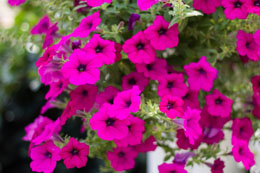One of the most widely grown flowering plants, petunias are very popular for their bright flowers and green foliage. Here is a brief overview about petunias.

Petunia is native to South America, and belongs to the family
Solanaceae and genus
Petunia. While most of the known varieties are hybrids, it is contented that their forerunner is a crossbreed between
Petunia axillaris with large, white flowers and
Petunia integrifolia, which has violet flowers. At present, a wide range of trumpet-shaped petunia flowers are available in different sizes, colors, and patterns.
Features
Petunia is a low-lying plant with a green and hairy foliage, and bright trumpet-shaped flowers. There are many hybrids that are roughly classified into four groups - grandiflora, hedgiflora, multiflora, and milliflora. Grandiflora consists of those petunias with the largest flowers, i.e., up to four inches in diameter. They are further divided into four groups -
merlin blue morn with blue and white flowers,
supercascade series with flowers in many colors,
daddy series with pink or purple flowers, and
ultra series, with blooms in many colors.
The plants in the second category or hedgiflora are commonly known as spreading petunias. Most of the plants in this category have a maximum height of up to six inches, and they cover a large area of up to four feet. The most popular among these types are the
opera supreme with large flowers and
tidal wave, which is much taller than the other members.
The third group called multiflora includes plants that produce flowers, which have a diameter of up to two inches. As compared to grandiflora varieties, these plants and blooms cannot be easily damaged by rain. The popular varieties include
carpet series with flowers in many colors and
surfinia series, which has blooms in pink, blue, purple, and white. The fourth and last category is milliflora, which has the smallest petunia flowers. The flowers in this category have a diameter of up to one inch. These plants are found to be more tolerant to harsh weather.
How to Grow Petunia Flowers
Petunias are plants, which are easy to grow and need less maintenance. They have some basic requirements, like good sunlight, moist and well-drained soil, and water. Choose the right plant, with the color of your choice. Select the site for growing these plants. They can be grown in garden beds, containers, window boxes, or hanging baskets. In short, petunias can be grown both outdoors and indoors. You can select plants as per your requirement. For example, if you want petunia plants for garden beds, then low-lying, spreading varieties would be suitable.
- You can either buy seedlings at the time of planting, or sow the seeds eight weeks before the time of planting.
- Planting petunias is usually done after the last frost, during the onset of spring. Choose a location with full or partial sunlight. At least six hours of full sunlight, is necessary.
- The soil must be well-drained and moist. A peat-based mix containing perlite or vermiculite (for drainage) is found to be good for these plants.
- Once the preparation is done, you can start planting. They have to be planted at a distance of 12 to 18 inches, in case of garden beds. If you like them in containers, then plant two to three plants in the center of the container.
- Regular watering and fertilizing is good for petunias, especially for the new plants. This ensures continuous blooming.
- You may also use fertilizers at the time of planting. Usually, a ratio of one part fertilizer to four parts soil is found to be best for a healthy growth. Otherwise, use a water-soluble liquid fertilizer, once a month.
Petunias are perfect for those who like vibrant blooms in their garden. If you do not have these plants, get some from the local nursery.






 Petunia is native to South America, and belongs to the family Solanaceae and genus Petunia. While most of the known varieties are hybrids, it is contented that their forerunner is a crossbreed between Petunia axillaris with large, white flowers and Petunia integrifolia, which has violet flowers. At present, a wide range of trumpet-shaped petunia flowers are available in different sizes, colors, and patterns.
Petunia is native to South America, and belongs to the family Solanaceae and genus Petunia. While most of the known varieties are hybrids, it is contented that their forerunner is a crossbreed between Petunia axillaris with large, white flowers and Petunia integrifolia, which has violet flowers. At present, a wide range of trumpet-shaped petunia flowers are available in different sizes, colors, and patterns.